|
Locomotives designed and built by Thomas Parker
The
following is a brief description of several locomotives that
were built by Thomas Parker. The information was kindly supplied
by John Middleton, Ph.D., a mining engineer who has
carried out research on the mine railways of South Africa, where
he worked for a number of years.
Unfortunately
little is known about the locomotives built by
Thomas Parker, which are of great interest to
locomotive historians. If anyone has any further
information on the locomotives, perhaps from
contemporary periodicals, please contact us by clicking
on the link at the bottom of the page.
Locomotives exported to South
Africa
In South Africa one of
the key early influences was J. Hubert Davies who emigrated
there in 1889 and quickly established himself in the engineering
field. The company bearing his name went from strength to
strength and survives to this day as a multi-faceted engineering
concern. The first electric railway in South Africa was built
under Davies’ auspices and was on the Crown Reef Gold Mine.
The railway was first mentioned
in the South African Mining Journal (SAMJ) of 3rd
June, 1893 in a report which stated that two electric locos were on
order. On 9th September, 1893 the same journal
reported that two 20hp. Elwell-Parker electric
locomotives had arrived. By 24th February, 1894 trial runs were
taking place, and by 10th March, 1894 they were in
service. On 10th November, 1894 the journal reported
that the locomotives were working satisfactorily, and a similar
installation had been ordered for Langlaagte Royal.
The locomotives operated on a
previously horse-drawn 2'0" gauge railway, which was 6,000 feet
long (approx 1.8 km), laid with 20 lb/yard rail, and with a
ruling gradient of 1 in 40. It was electrified with a 500V DC
overhead line. Each locomotive weighed 10,000 lb (4.5 tons), ran at a
speed of 10 mph, and could haul 10 loaded or 20 empty
trucks of 30 cubic feet capacity, each weighing
1.5 tons. They are recorded as hauling 600-700
tons per day.
It now seems fairly clear that
the locomotives were probably built by the
E.C.C. (initially the Electric Construction
Corporation, becoming the Electric Construction Company in July
1893). Contemporary E.C.C.
adverts record the supply of an electric railway to
Crown Reef, which seems to confirm the company as the builder of the locomotives.
An article in the South African
Engineering Journal for May 1904 described a locomotive
built by E.C.C. but it is not certain whether this was
the same or different to those at Crown. Contemporary photos show outside framed
4-wheel locomotives, with a complete canopy roof and waist
high bodywork.
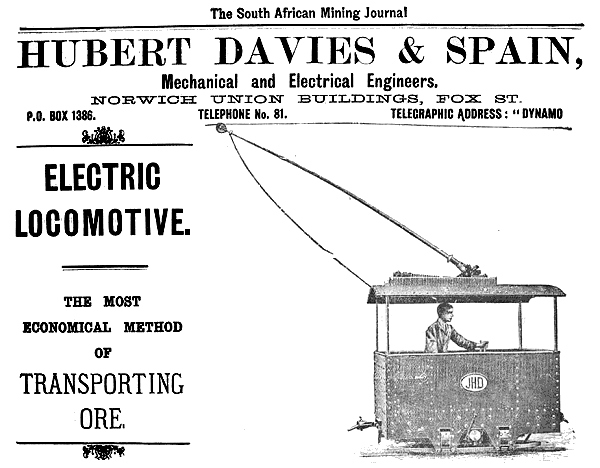
An advert for a Crown Mines E.C.C.
locomotive. From John Middleton's collection.
The locomotives were clearly a great success.
Hubert Davies soon built other
electric tramways including a line for the
Langlaagte Royal Gold Mining Company Limited which
used an identical locomotive to the ones in use in the Crown
Reef Gold Mine. It was in operation by 1896.
The 'British & South African Export Gazette'
for February 1897 stated that the Wemmer
Gold Mining Company Limited had ordered an electric
locomotive from Hubert Davies
that was similar to those working in the Crown
Reef, and Langlaagte Estate Company's mines. It is
possible however, that the Langlaagte
Estate mentioned in the report should actually be Langlaagte Royal
which closed in November 1896. Its locomotive, being virtually new, was likely sold to
another mine.
The Transvaal Government Mining
Engineers report for 1897 stated that seven
electric locomotives were in use, which probably included
at least four by E.C.C. / Parker (The two at Crown Reef and
at least one each at Langlaagte and Wemmer). It
would be nice to know how many were actually exported to South
Africa.
|
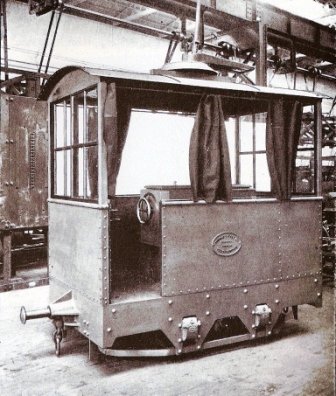
A Thomas Parker Locomotive in
the workshop: 'Cassiers Electric Railway 1899'. From
the collection
of Chris West.
|
The photograph opposite is from
'Cassier's Electric Railway' from
1899 and is captioned 'A locomotive built for the
South African Gold Fields by Messrs Thos. Parker
Ltd., Wolverhampton, England'.
The picture is in an
article titled 'The Electric Locomotive' by George R. Mair. Unfortunately Mair does not give his sources.
The builder's plate carries the
name Thomas Parker Limited at the top, with Wolverhampton at the
bottom. |
| The following text from Mair's article may be of
interest: The position of
the electric locomotive amongst the general mining
apparatus is illustrated in the South Africa gold
fields. The discovery of these fields is so recent
that the equipments for working them naturally
afford examples of the highest development in the
special class of machinery required. In one of the
first systems of mechanical haulage on the Rand
electric power was adopted. Two locomotives of
British make were installed at the Village Main Reef
Mine, where they have been in operation for a number
of years. While these machines are not used for
underground service, their general construction is
of the character employed for mine locomotives, and
the results shown have been so excellent in this,
the first plant in the Johannesburg district, as to
warrant the belief that in the near future the
electric system will be generally adopted on the
Rand.
It is possible that Mair is referring to the
Wemmer locomotives which ran through the Village Main
property. It is quite possible that the photo of
the Thomas Parker locomotive might be the Wemmer
locomotive of 1897 or another, yet to be identified.
Other Locomotives
A Thomas Parker locomotive
was supplied to Broken Hill Proprietary in Australia in
1902. It has a similar frame to the South
African locomotives, which is a distinguishing feature of Parker locomotives, as was the
large size and position of the builder's plate.
A number of standard gauge versions are known to
have been used in the UK and can be seen in photos
that appear in various
Industrial Railway Society publications.

A standard gauge
locomotive
built by Thomas Parker around 1895. It
worked at Henry Bruce & Sons Limited, Kinleith Paper
Mills, Currie (off the Caledonian Railway's Balerno
Branch). It was scrapped in the mid 1960s.
Courtesy
of Richard Horne. |
|
From 'The Engineer',
27th January, 1899:
Contractors'
Electric Locomotive
Thomas Parker Limited,
Wolverhampton, Engineers
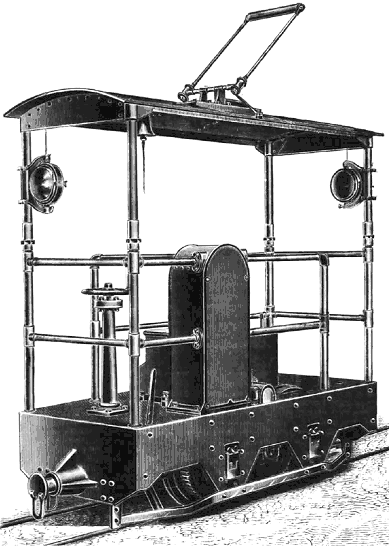
Contractors'
Electric Locomotives
Six contractors'
electric locomotives for the
Baker Street and Waterloo
Railway are being made by
Messrs. Thomas Parker, Limited,
of Wolverhampton. Our
illustrations show a general
view and details of these
locomotives. They have been
specially designed to meet the
conditions of Messrs. Burstall
and Monkhouse's specification,
which among other things
provides that the maximum width
overall should not exceed 3 ft.
The result has been that space
has had to be economised to the
utmost extent, and an extremely
handy locomotive produced.
No working parts
are uncovered, though all
portions of the machinery are
easy of access, and there is a
glass window over the commutator,
by means of which the behaviour
of the brushes can be observed.
The current will be obtained
from an overhead wire, from
which it will be collected by a
long contact roller bar, instead
of the
more usual grooved wheel, thus
permitting of a greater sideway
deviation of the conductor wire
without fear of breaking
contact. The wire conveying the
current to the switch passes
down from the roof of the
vehicle through one of the
upright tubes placed at each
corner of the footboard.
Each locomotive
is fitted with a series motor,
the armature of which is wound
with Messrs. Parker's patented
Eickemeyer coils, and connected
by double helical gearing to
both the axles. The locomotive
develops 15 to 20 brake
horsepower when supplied with
current at an electromotive
force of 200 volts, and it is
designed to run at ten miles an
hour on a level track. The gauge
of the rails is 18in. The
starting and reversing motions
are controlled by one handle.
This handle works a throw-over
reversing switch, fixed at the
top of an enclosed box, and is
also geared to a resistance
switch, the contacts of which
are connected to resistance
coils of platinoid inside the
box.
A light iron
detachable canopy or roof is
fitted so that it can be taken
off in case it is required to
pass the locomotive through a
small opening. The motors are
entirely enclosed in the frame
of the locomotive, to protect
them from dust and wet. Lamps,
efficient brake and sand boxes,
together with buffers which form
part of the
drawbars, render these
locomotives complete in every
detail. A dimensioned outline
plan and elevation of the
locomotive are given, and the
view above represents the
locomotive in working order. It
will be noticed on reference to
these illustrations that the
arrangement is very compact, and
that the driving is intended to
always be from one end of the
locomotive, the controlling and
brake handles and the two sand
box levers being all accessible
from one place.
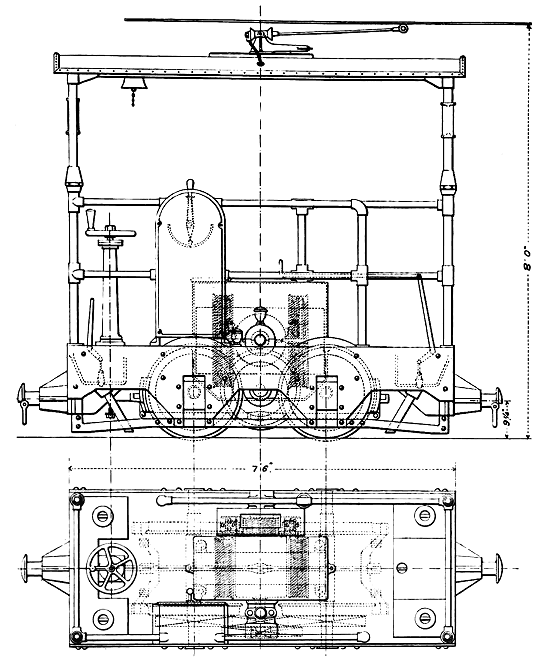 |
|
| |
|
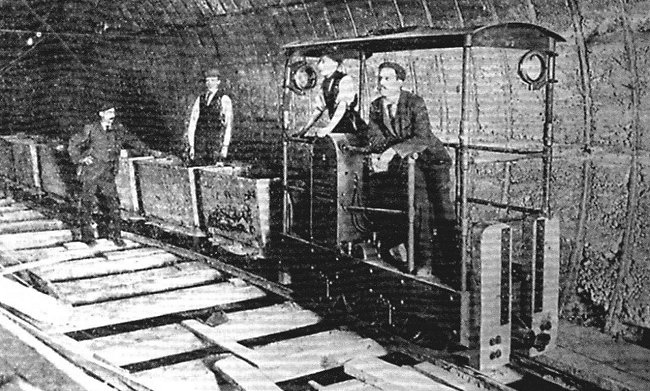
One of the
locomotives in use during the
construction of the Bakerloo Line.
Courtesy of John
Browning. |
| |
|
From 'The Engineer',
31st May, 1901:
Standard Gauge Electric Locomotive
Thomas Parker Limited,
Wolverhampton, Engineers
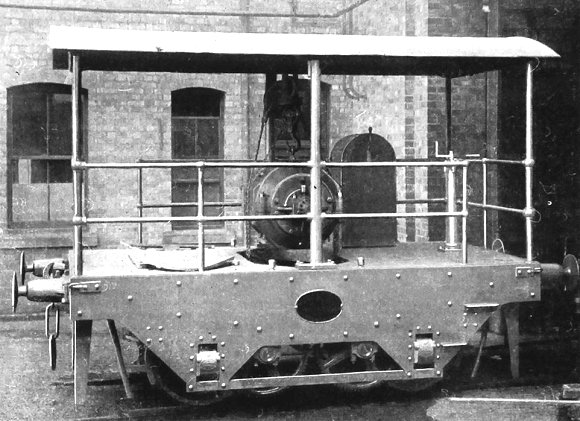
The accompanying illustration
represents a new electric locomotive
recently designed and built for
Lowdon Brothers and Co., of Dundee,
by Thomas Parker, Limited, of
Wolverhampton. It is full gauge,
4ft. 8½
in., and is intended for hauling
trucks from the main line into a
goods siding. It is to be capable of
taking 45 tons up a gradient of 1 in
100 at about four or five miles an
hour, and lighter loads up the same
gradient at correspondingly higher
speeds up to a maximum of eight
miles an hour.
In general construction the
locomotive is very similar to that
made by the same firm for working in
the Waterloo and Baker Street
Railway tunnels, of course, it is on
a much larger scale. The smaller
locomotive we illustrated. The
present illustration shows how the
driving motor can be lifted from its
place for inspection or repair
without taking the locomotive under
a crane. In the roof there is a ring
fastened to one of the supports. To
this a set of pulley blocks can be
attached, and the motor raised by
means of an eye bolt on the top of
the casing. Ordinarily speaking, of
course, the motor is lowered down so
as to be in contact with the gear
wheels, and is, in fact, below the
footboard, and the hole covered in
with chequer plates.
The motor is of the 4-pole enclosed
ironclad type, with carbon brushes.
The armature is wound with
Eickemeyer coils, as are all the
machines made by this firm. The
magnet yoke and the cover are cast
together, with the joint on the
horizontal diameter. The motor
develops from 40 to 50 brake
horsepower when supplied with
current at 200 volts. It is made
both water and dust proof, but lids
are arranged so that access may be
obtained to the brushes. As will be
seen, the general design is quite
simple. There are two buffers
instead of the single buffer of the
earlier and small locomotive already
referred to. There are also sand
boxes and powerful brakes. Hooks are
provided at the four corners for
rope traction. The frame proper is
built up of a heavy cast iron body,
with bearings for the countershafts
cast on the underside. The bearings
are provided with loose caps. On the
cast 1ron body are bolted rolled
steel plates,
¾
in. thick carrying cast steel
hornblocks for the axle boxes. The
gear is double reduction with two
countershafts. The motor gears at
each end of the spindle into these
countershafts which are on the same
horizontal line as the centre line
of the axles so that the moving of
the locomotive on the springs does
not affect the teeth which are in
gear with the axle gearwheels. The
diagram below shows the arrangement
and size of the wheels.

The controlling gear is placed in a
box at one side and fastened to the
hand railing. The starting,
stopping, regulating and reversing
switches are all operated by one
handle. Quite near by is the brake
handle so that both are within easy
reach of one driver. The complete
weight of the whole locomotive is 12½
tons. The current is collected by a
trolley arm, which does not appear
on the engraving. An ordinary
tramcar trolley base is fixed on the
locomotive footplate and rises
through a hole in the roof.
|
|
Locomotives in Australia
The following
reports from various newspapers were sent to John
Middleton by John Browning of Brisbane. They tell
the story of the installation at
Broken Hill
Proprietary Mine, New South Wales.
|
The
Barrier Miner, Saturday 25th January, 1902
THE B. H. PROPRIETARY
Electric Trains Underground.
ARRANGEMENTS are now proceeding for the introduction of
electric tramways underground at the 650ft. in place of the
present horse traction, and for this purpose an engine and
dynamo are being installed on the mine. The cables are now
being laid, and operations will be started in a few weeks.
At present 52 horses are being used for truck work at the
300ft. and other levels to the 650ft, and these are being
sent up and down every shift, each horse working eight hours
daily. Provided the new system proves a success at the
650ft., it will also be extended to the other levels. Mr.
O'Neill, of J. A. Newton and Co., Melbourne, is
superintending the installment.
|
|
|
The Barrier Miner, Thursday 6th
February, 1902
THE B.H. PROPRIETARY
The Electric Installation.
IN connection with the electric traction at the Broken Hill
Proprietary's 650ft. level, the overhead trolley wire is
laid, and men are now making copper connections across the
fishplates, with the object of reducing the resistance of
the rails which carry the return current.
Driving is proceeding at the 650ft., and the connections at
that level should be made in five or six weeks.
The electric locomotive specially built for the company by
Thomas Parker and Co., Limited, Wolverhampton, to suit the
undulations underground has arrived on the mine. It is of 15
h.p., and is capable of hauling 25 tons at a speed of five
miles an hour. It is understood that pending the completion
of the 650ft. drive this locomotive will be run on the dump
in place of horses to take out tailings.
|
|
|
The Advertiser, Monday 17th
February, 1902
BROKEN HILL, February, 16
Some interest was taken on Saturday in the trial run of the
electric motor, which is at work at the Proprietary mine's
principal dump. The result was most satisfactory, the motor
drawing eight full trucks of tailings with ease. It is
expected that next week the system will be in full working
order.
|
|
|
The Barrier Miner, Wednesday 26th
February, 1902
The Broken Hill Proprietary
New Processes and Economies
The electric locomotive is now regularly removing tailings
from the old mill, and has drawn at one time as many as 16
loaded trucks. This locomotive is capable of doing the
traction work of both mills if wiring was laid; as it is, it
does away with the services of eight or nine horses.
The connections have been made at the 650ft. level, between
McBryde and Patterson shafts, and also with Patterson and
Delprat shafts, thus making through communication from
Delprat shaft to Block 11. A station plat will be excavated
at Stewart shaft, and when this is done the work of laying
the electric traction and cables and bonding the rails will
be completed.
|
|
|
The
Barrier Miner, Tuesday 11th March, 1902
The Broken
Hill Proprietary.
The installation of the electric traction plant at the 650ft
at the Proprietary will be completed on Saturday next. The
length of line laid is about 2500ft., giving communication
with Delprat and McBryde shafts and the workings on the
south boundary of Block 11.
The electric
locomotive which has been running lately on day shift with
tailings from the Proprietary's old mill on a trial of
strength yesterday evening took out 25 full trucks. From
appearance it could readily draw from 30 to 35 trucks if
required.
|
|
|
The Register, Wednesday 19th March, 1902
BROKEN HILL
March 18. The electric locomotive had a trial
run yesterday at the 650 level on the Proprietary. It travelled from McBride's to Patterson's and then on to
Delprat's shaft. Although the track was not quite completed
it ran very satisfactorily. Afterwards it conveyed a rake of
twenty full trucks at the rate of five miles an hour from
McBryde's to Delprat shaft, returning with empties. Mr. T.
Mars, a local electrician, supervised this installation for
Newton and Co., electrical engineers, of Melbourne.
|
|
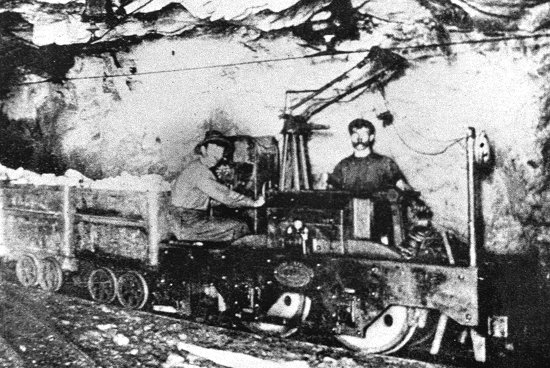
The Thomas Parker locomotive
at
Broken Hill Proprietary. Courtesy of Richard Horne.
|
The
Barrier Miner, Wednesday 14th May, 1902
ELECTRIC TRACTION UNDERGROUND.
The electric traction plant lately installed at the 640ft.
will this week be put into regular service and will run over
approximately 5500ft. of track already laid, including cross
cuts extending from Delprat shaft to nearly as far as Block
10 boundary. The plant comprises a small electric
locomotive, developing about 15 h.p and on a level track
runs at about eight to 10 miles an hour. Its maximum width
is 3ft., the working parts being all covered over, but easy
to get at. The motive power is obtained from a continuous
generator at 220 to 240 volts, put down for this purpose,
developing a power sufficient to supply two or three locos
of the same size. It can easily handle 20 trucks or more, if
wanted, whilst one horse could not conveniently draw more
than five or six full trucks. Should this principle be
extended throughout the mine, on surface and
underground, and this is more than probable, although it is
too early yet to compare cost with that of horse traction, it
would throw over 100 horses out of service, and would
relieve the workings of the trouble and many disadvantages
of animal traction. About 15 horses are employed below
surface each shift, and these have to be caged up and down
at every change, which entails considerable expense and loss
of time, beside which they make a mess of the track ; and
unless the ventilation is complete they foul the air.
Mr. F. Mars, engineer and part proprietor of the local
Electric Light and Power Station, who supervised the
installation of the Proprietary's plant, supplies some
details of the work. He explains that the current at 220
volts is collected from an overhead trolley wire by a roller
rubbing contact, which allows ample sideway deviation on the
trolley wire for any irregularities of the track. The track
gauge is 18in. The rails weigh about 24lb. per yard, and one
rail of the track is electrically bonded throughout and used
as the return circuit. Bonds of 7-14 S. W. G. cable 15in.
long, the ends being sweated into ½in. brass thimbles, are
fitted into holes drilled in the rails at each end of the
fish- plates and expanded tightly therein. The trolley wire
is suspended 6 ft. 9in. from the rails by insulated
"hangers" sweated on to the wire and bolted to Oregon pegs
driven into holes drilled in the crown rock of the drives.
The hangers are spaced 20ft. apart on the straight track,
and 6ft. to 8ft. apart at the crosscuts and curves; both the
trolley wire and rails are fed from the generator (on the
surface) down 650ft. of shaft by 19-14 S. W. G. cable,
which is of ample size at present. The overhead wire has
switches arranged at each crosscut leading into the ore
faces, to enable these sections to be cut out of circuit in
case of damage caused when shooting down the ore, otherwise
the
whole track would be unworkable until repairs could be
effected. The whole of the plant for this installation has
been supplied from Messrs. Thomas Parker, Limited, of
Wolverhampton (England), by Messrs. J. and A. Newton, of
Melbourne. |
|
|
The
Barrier Miner, Saturday 17th January, 1903
Electric Traction Underground.
For about nine months the Broken Hill Proprietary has been
using electric traction in the place of horses at the 650ft.
It was, however, found that the locomotive used was
cumbersome, and there was at times some trouble in
negotiating the short drives and curves; so it was decided
to replace it
|
|
|
Kalgoorlie. The Western Argus, Tuesday 19th January, 1904
The electric locomotive of 15 h.p. has been removed from the
600ft. level, where it has been working for some time, to
the surface, at the Broken Hill Proprietary, where it is now
taking the place of horses. Recently it started with a rake
of from 20 to 25 trucks, and has been found to answer
admirably.
|
|
|
Sydney Morning Herald, Monday 8th February, 1904
The electric motor continues to work satisfactorily
resulting in considerable economy, many horses having been
displaced by the motor.
|
|
Mines are dangerous places, and people do
occasionally get hurt. The following
newspaper reports are of accidents involving
the Thomas Parker locomotive.
|
|
The Advertiser, Wednesday 18th February, 1903
BROKEN HILL, February 17
Thomas Matheson had a peculiar experience at the Proprietary
mine last night. Just before the afternoon shift knocked off
he was carrying some steel bars along a drive at the 640-ft.
level on block 11, when his burden came into contact with an
electric wire. Matheson received a severe shock, which
prostrated him for some time, but afterwards he appeared
sufficiently recovered to go home when the shift knocked
off. After reaching the surface he was again overcome by the
effects of the shock, and was removed to the hospital.
|
|
|
The
Barrier Miner, Sunday 30th April, 1905
ACCIDENTS
Charles Partridge, employed on the Proprietary mine, was
working on the dumps on Saturday evening when he caught hold
of a live electric wire and received a bad shock. Three of
his fingers were severely burnt. Partridge was removed to
the Hospital in the ambulance. |
|
|
The
Barrier Miner, Monday 6th March, 1908
MINE ACCIDENTS.
At about 6 o'clock last night William Gourlay, a motor boy
employed on the electric motor at the Proprietary mine, fell
off the motor and had his ankle badly crushed by the trucks. Gourlay, who is 17 years old, was conveyed to the Hospital.
|
|
|
The
Barrier Miner, Friday 10th March, 1908
MINE ACCIDENT.
At about 6.30 last night T. B. Radbone, a motor boy at the
Proprietary mine had his leg broken through being run over
by the motor. Radbone, who is 19 years old, was working on
the electric motor drawing trucks out over the dump. He
jumped off the motor and fell, und it passed over his leg,
which was broken just above the knee.
|
|
|
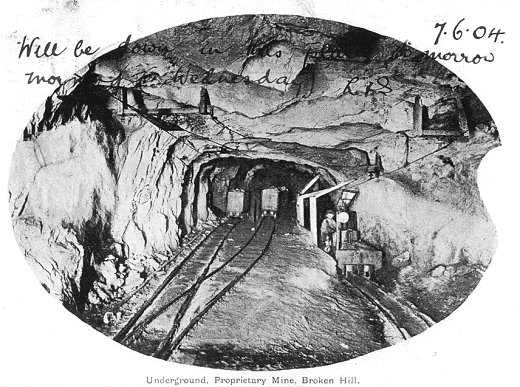
A final view of the Thomas Parker
locomotive. Courtesy of Richard Horne.
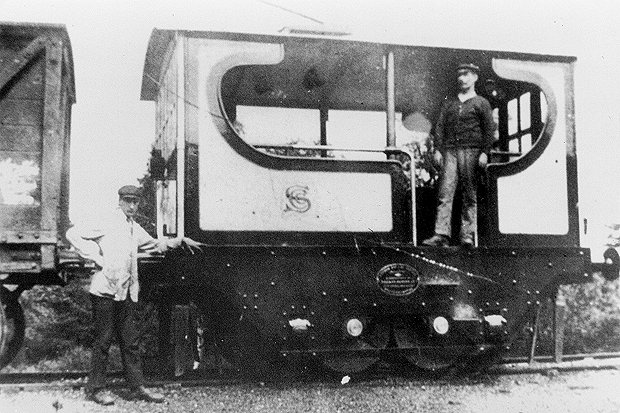
| A Thomas Parker
locomotive that worked on the Cheddleton
Hospital Railway in Staffordshire. Courtesy of
Mark Cornwell. |
|
|
I must thank John Middleton for supplying the
fascinating information about the Parker locomotives. If you have
any other information about the locomotives, or can add to this
section, please send me an email.
Anything you can add will be most welcome.

|
Return to the
previous page |
|
|